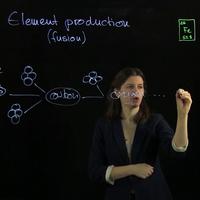Ep. 6: Element Production (Fusion) -- Part 1
Have you ever wondered how all the chemical elements are made? Then join me
as we are lifting all the star dust secrets to understand the cosmic origin of the
chemical elements. Why do stars shine? Why do we have sunlight every day? Well it's
because of nuclear fusion.
Nuclear fusion is going on in the core of the Sun.
Hydrogen to helium gets converted there and that gives the Sun enough energy to
sustain its luminosity for billions of years. How does this work?
Let's have a look. We want to reproduce what is going on in the Sun
and what's basically happening, is that 4 protons -- which also are just
4 hydrogen atoms -- come together in a series of steps that we are going to
leave out for now, and they form a helium atom. That's made from 2 protons
and 2 neutrons. So we have some conversion of 4 protons here into
2 neutrons into 1 helium. This actually works only because there is quantum mechanical
tunneling going on. That's a really cool thing. Ordinarily these positively
charged protons would actually repel themselves. But in the Sun it's
really quite hot. Not quite hot enough for them to all fuse straight up but
because of this tunneling effect it's hard enough -- just hot enough -- so that
these protons can combine to eventually form a helium nucleus. This kind of
tunneling effect is important for all subsequent fusion processes,
namely if we have another helium here
and another one, so if we put all of those together, we're going to get a carbon
nucleus. This is the carbon nucleus, and if we're going to add another helium to
that we're going to get oxygen. If we add more so-called alpha-particles
-- helium nuclei often called alpha- particles -- then eventually we're going to
get to iron. Now how does this help us understanding why the sun shines?
As it turns out, these lightest nuclei here are much less
tightly bound than the big ones like iron. That means we're going to get a
little bit more energy out of this than that. Now let's look at some details and
then come back to this. So if we're going to look at the constituent
here, 4 protons which make up one helium nucleus, and then we know 1 helium
nucleus consists of 2 neutrons and 2 protons. If we make
a little experiment and we weigh 1 helium nucleus and then we weight 2
neutrons and 2 protons separately, we're going to find out that the helium
nucleus actually weighs a little bit less than my initial constituents here.
Actually it's 0.73 percent that our final helium nucleus here weighs less
than these constituents. And that's really fantastic! This is called a
mass defect, and you've all seen the equation e = m * c^2
usually with a picture of Einstein attached. This here, this is a little
mass, a little mass difference. And if you stick that in here, you multiply
it with the speed of light squared which is just the constant, so just a
number, you're going to get out energy. And that is the energy that the Sun is
using to shine every day. This is the nuclear energy that stars produce. Now
this amount of energy that gets out becomes successively less if you go to
heavier and heavier nuclei and if you were to try to fuse two iron atoms
together, you're not going to get out anything. So iron atoms will not give you
any fusion energy with this here because this here is zero. Actually
you would need to put energy in if you
wanted to fuse two iron atoms. Obviously the star is going to have a
big problem because it doesn't want to, you know, put energy in and wants to get
to energy out. That's why, in the end, the star ends up with an iron core.
This is an iron core, here, these fusion processes have been going on in the
center, and growing larger and larger as more and more elements are being made.
And eventually, if there is a big fat iron core sitting there, and since it
can't get any energy out anymore, the star has a big problem
because it needs to have an energy source. Without that, it explodes
as a supernova.

